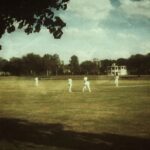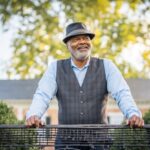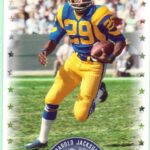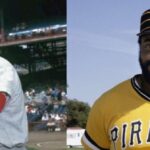As the Saints March in to the Super Bowl, A Sister City begins a March of Its Own
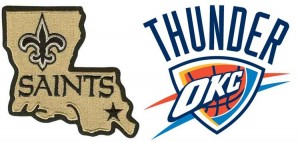
New Orleans and Oklahoma City are linked by tragedy and redemption.
Linked by Tragedy and Bonded by Response to Tragedy, New Orleans and Oklahoma City Walk the Same Road to Redemption
The New Orleans Saints have propelled their city to the center of the sports world’s attention, and are the sentimental favorite of most of the “uncommitted” fans as the Super Bowl approaches. They’ve been called the new, “America’s Team,” and one recent article has dubbed them, “God’s Team.”
In addition to having lived with 40 years of “Who Dat?” frustration over Saints football, New Orleans has earned the sympathy and support of much of the country for everything they suffered during Hurricane Katrina, and the after-effects that continue to persist.
But many years before Katrina, Oklahoma City experienced an event that was at least equally devastating to the civic psyche as New Orleans’ natural disaster.
Timothy McVeigh’s bombing of the Murrah Federal Building had broken the backs and hearts of this proud, resilient city. As a result, much like New Orleans would later be, the town was down but not out; broken but not bowed.
Their response to McVeigh was to build a Riverwalk. Around it they created an entirely new, vibrant, bohemian district they call Bricktown.
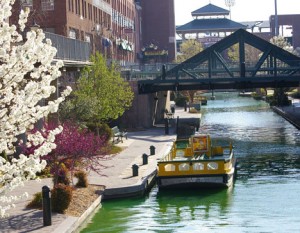
Oklahoma City built a beautiful waterfront following the 1995 bombing.
That was their nod to the future.
At the same time, they saluted their past.
At a church across from the Murrah site, there’s an extremely powerful statue of a larger-than-life Christ turning his back in grief on the site of the bombing.
If you’ve seen this in person, you feel the same pain—the pain of a father or mother looking away from the mangled corpse of his or her own child. If you come away from there without tears in your eyes, you can’t be human.
But that’s not the end of the story.
Now cross the street. A stunning memorial was built on the site of the tragedy.
There is a block-long reflecting pool, where the Murrah Building stood. From any angle, one can see nothing in the pool but a vivid, mirror-clear copy of the city’s refurbished skyline.
Around the pool, empty chairs sit in odd configurations, one for each person who died there, in the exact location where each was found.
Unless you’ve seen it, you can’t imagine the power of this place, how beautifully it captures the pain, the memory, and yet just as poignantly, the hope and triumph of a city that refused to lose hope.
It was providential then, that in the aftermath of Katrina the two cities were linked in an unusual but amazing way.
Just as Oklahoma City had risen from its ashes, it became the “foster home” to a team from another city just buried in its own: the New Orleans Hornets of the NBA.
Just as the Saints were forced to play a season away from the Superdome, due to the devastation that took place in the stadium, the Hornets were left homeless for two seasons while the city struggled to repair their venue, New Orleans Arena.
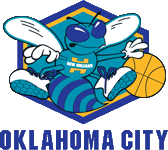
The New Orleans Hornets spent two seasons as the New Orleans-Oklahoma City Hornets following Hurricane Katrina.
Having just completed Ford Center (arena) with the goal of attracting a NBA team, Oklahoma City became the Hornets’ “foster home.” During those years, they were known as the New Orleans-Oklahoma City Hornets.
By the time the Hornets arrived, Oklahoma City had finished rebuilding the physical damage done by the bombing, but was still on the mend in terms of their collective sense of well-being. Having the Hornets in town gave OK City a new sense of identity and something positive to rally around that gained the community national recognition.
Despite knowing that the Hornets would almost certainly return to New Orleans when their arena was repaired, the Oklahoma City fans still welcomed the team as their own. They sold out Ford Center routinely, and cheered passionately for their temporary franchise.
Until then, no one would have considered Oklahoma City a major league venue in any sport. Who would have thought there would be any oxygen left in Central Oklahoma for any team that didn’t wear red and dance to “Boomer Sooner”?
But something emerged from that kinship of sorrow with New Orleans.
It’s true that by the time the Hornets arrived, the Seattle Sonics had been purchased by a group of Oklahoma investors. Ford Center had been built in hopes of luring the NBA.
But you can lead a Sooner to a backboard, and still they may not shoot.
The opportunity to be a refuge to a strange team from a strange sport created a permanent space for the NBA in a way that just absconding with the Sonics could never have done.
Oklahoma City, as it turns out, used the Hornets’ two-year exile as a dress rehearsal for things to come.
Exit, Hornets. Enter, Thunder.
Once one of the league’s most successful franchises, the Sonics were a shell of their former selves. Ironically, given the presence of the FAA training center and Tinker Air Force Base in OKC, they could have, perhaps should have kept the Sonics name.
At first, the new name gave rise to an unflattering nickname that rhymes with it—”Blunder.”
More blunder than thunder in the first season, the cellar-dwellers challenged OKC fans’ stomach for futility, and their capacity for loyalty, losing much more than winning (unlike the Hornets during their brief tenure) and often by lopsided scores.
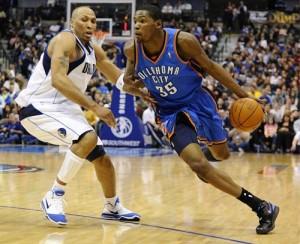
Oklahoma City Thunder fans hope that their team can rise to the same level as the New Orleans Saints.
This year, as the Saints have finally overcome 40 years of frustration and their city’s unprecedented devastation, it may be less than coincidental that in only their second year as Oklahoma City’s team, the Thunder are a “Blunder” no more. Led by rising superstar Kevin Durant, the Thunder is among the NBA’s most improved teams and is in the running for a playoff berth.
It appears that there is a force beyond that which can be quantified and analyzed by sports pundits and handicappers that is driving these two cities on parallel tracks toward victory that, if achieved, will mean a lot more than points on a scoreboard or trophies in a glass case.
No wonder then, that the Saints are America’s Team. Do not be surprised if the Thunder, located in the NBA’s smallest, as well as its newest market, become so as well– if not this year, then soon.
John Wingspread Howell is a speaker, writer, theologian and consultant. He publishes the e-zine Underdog Sports www.underdog.sports.officelive.com. He is available to speak to your organization or event by contacting him at www.johnwingspreadhowell.com/scheduleanappearance.aspx

